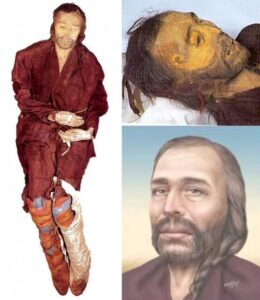European Mummies Found In The Taklamakan Desert, Xinjiang

In a startling discovery that has captivated the world, European mummies have been unearthed in the heart of the Taklamakan Desert in Xinjiang, China. This remarkable find challenges conventional notions of ancient migration patterns and offers a glimpse into the intricate tapestry of human history.
The Taklamakan Desert, known for its harsh and unforgiving terrain, has long been a focal point for archaeological exploration. Yet, the revelation of European mummies within its arid expanse has stunned researchers and ignited a flurry of scholarly inquiry.
These mummies, remarkably preserved by the dry desert air, provide a window into the lives of individuals who traversed vast distances in antiquity. Clad in garments adorned with intricate patterns and accompanied by artifacts that speak to their cultural heritage, they offer tantalizing clues about ancient trade routes and intercultural exchange.
Analysis of the mummies’ physical characteristics and genetic markers has yielded surprising insights into their origins. While their presence in the Taklamakan Desert may seem incongruous at first glance, it underscores the complex movements of ancient peoples and the interconnectedness of civilizations across vast distances.
Moreover, the discovery of European mummies in Xinjiang raises intriguing questions about the interactions between East and West during ancient times. Did these individuals journey to the region as traders, adventurers, or perhaps even refugees? What cultural exchanges took place between them and the indigenous populations of Central Asia?
As researchers delve deeper into the mysteries surrounding these enigmatic figures, the story of the European mummies of the Taklamakan Desert continues to unfold. Each new revelation adds another layer to our understanding of human history and reminds us of the profound connections that transcend geographical boundaries and span millennia.




